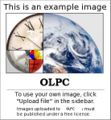OLPC Human Interface Guidelines/Activities/Introduction/lang-es: Difference between revisions
m (nav & translation templates) |
|||
| (5 intermediate revisions by 3 users not shown) | |||
| Line 1: | Line 1: | ||
<noinclude> |
<noinclude> |
||
{{OLPC}} |
|||
| ⚫ | |||
{{Translation | lang = es | source = OLPC Human Interface Guidelines/Activities/Introduction | version = 17628 | source_display = OLPC-HIG-Activities/Introduction}} |
|||
| page_display = OLPC HIG-Activities/Introduction |
|||
| version_http = http://wiki.laptop.org/index.php?title=OLPC_Human_Interface_Guidelines/Activities/Introduction&oldid=17628 |
|||
| version_display = 2006-12-06 16:58:09 |
|||
| diff_http = http://wiki.laptop.org/index.php?title=OLPC_Human_Interface_Guidelines%2FActivities%2FIntroduction&diff=current&oldid=17628 |
|||
}} |
|||
</noinclude> |
</noinclude> |
||
<div style="background-color: #FFF; margin-left:auto; margin-right: auto; width: 95%;"> |
<div style="background-color: #FFF; margin-left:auto; margin-right: auto; width: 95%;"> |
||
| Line 14: | Line 9: | ||
| n_link=Activities/Activity Basics}} |
| n_link=Activities/Activity Basics}} |
||
{{anchor|A New Model}} |
|||
===Un Nuevo Modelo=== |
===Un Nuevo Modelo=== |
||
<font size="1"><span id="anchor_name">A New Model</span></font> |
|||
Cada actividad con su imagen a vista previa e informacion de como se juega,y de que es el juego |
|||
| ⚫ | Hacemos una diferenciación entre el típico modelo mono-aplicación, multi-documento computacional y la |
||
| ⚫ | |||
<gallery> |
|||
<gallery> |
|||
Image:Example.jpg|Caption1 |
|||
Image:Example.jpg|Caption2 |
|||
</gallery> |
|||
<gallery> |
|||
<gallery> |
|||
Image:Example.jpg|Caption1 |
|||
Image:Example.jpg|Caption2 |
|||
</gallery> |
|||
<gallery> |
|||
Image:Example.jpg|Caption1 |
|||
Image:Example.jpg|Caption2 |
|||
</gallery> |
|||
</gallery> |
|||
</gallery> |
|||
==={{:OLPC Human Interface Guidelines/Activities/Introduction/lang-es/title}}=== |
|||
| ⚫ | Hacemos una diferenciación entre el típico modelo mono-aplicación, multi-documento computacional y la interfaz de pantalla completa de la OLPC, donde cada objeto (documento) se ejecuta dentro de propia instancia—múltiples instancias de una dada actividad pueden ejecutarse en paralelo. Las instancias de las actividades dentro de Sugar proveen una manera de manipular los archivos como objetos; cada instancia puede representar un conjunto diferente de individuos que colaboran, y crear una nueva instancia de una actividad de Dibujo implica la creación de un nuevo dibujo. Las acciones de "Abir" y "Grabar" son relegadas a una interacción con el diario. De hecho, resaltamos esto al remplazar la noción de "Grabar" por una mas noción más general de "Guardar" cosas. Para "abrir" un dibujo que se ha guardado, basta con [[OLPC Human Interface Guidelines/Activities/Activity Basics/lang-es#Resuming_Activities|retomarla o resumirla]]. |
||
| ⚫ | |||
| ⚫ | We make a distinction between the typical single-application, multi-document model of computing and the OLPC full-screen activity interface, where each object (document) runs within its own instance—multiple instances of a given activity may run in parallel. Activity instances within Sugar provide a way to handle files as objects; each instance may represent a different group of collaborating individuals, and creating a new instance of the Draw activity implicitly creates a new drawing. "Open" and "Save" actions are relegated to a journal interaction; In fact, we strengthen this by replacing the notion of "Saving" with the more general notion of "Keeping" things. To "open" a drawing you've kept, you simply [[OLPC Human Interface Guidelines/Activities/Activity Basics#Resuming_Activities|resume]] it. |
||
| display = block }} |
|||
{{hig-subnav-inter-lang | lang=es |
{{hig-subnav-inter-lang | lang=es |
||
Latest revision as of 22:01, 17 March 2009
Un Nuevo Modelo
Cada actividad con su imagen a vista previa e informacion de como se juega,y de que es el juego
</gallery> </gallery>
Introducción
Hacemos una diferenciación entre el típico modelo mono-aplicación, multi-documento computacional y la interfaz de pantalla completa de la OLPC, donde cada objeto (documento) se ejecuta dentro de propia instancia—múltiples instancias de una dada actividad pueden ejecutarse en paralelo. Las instancias de las actividades dentro de Sugar proveen una manera de manipular los archivos como objetos; cada instancia puede representar un conjunto diferente de individuos que colaboran, y crear una nueva instancia de una actividad de Dibujo implica la creación de un nuevo dibujo. Las acciones de "Abir" y "Grabar" son relegadas a una interacción con el diario. De hecho, resaltamos esto al remplazar la noción de "Grabar" por una mas noción más general de "Guardar" cosas. Para "abrir" un dibujo que se ha guardado, basta con retomarla o resumirla.
We make a distinction between the typical single-application, multi-document model of computing and the OLPC full-screen activity interface, where each object (document) runs within its own instance—multiple instances of a given activity may run in parallel. Activity instances within Sugar provide a way to handle files as objects; each instance may represent a different group of collaborating individuals, and creating a new instance of the Draw activity implicitly creates a new drawing. "Open" and "Save" actions are relegated to a journal interaction; In fact, we strengthen this by replacing the notion of "Saving" with the more general notion of "Keeping" things. To "open" a drawing you've kept, you simply resume it.
